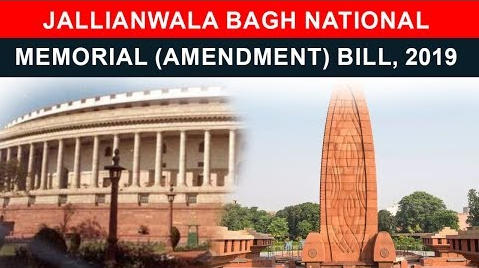Table of Contents
Q) The people were gathered in Jallianwalla Bagh to protest the arrest of whom among the following leaders?
- Bhagat Singh and Dr. Satyapal
- Bhagat Singh and Rajguru
- Dr. Saifuddin Kitchlu and Mahatma Gandhi
- Dr. Saifuddin Kitchlu and Dr. Satyapal

- The bill was also passed by Lok Sabha in the previous tenure of NDA govt.
WHY THIS BILL?
- The bill amends the Jallianwala Bagh National Memorial Act, 1951.
- The Act provides for the erection of a National Memorial in memory of those killed or wounded on April 13, 1919, in Jallianwala Bagh, Amritsar.
- It creates a Trust to manage the National Memorial.

Under the 1951 Act, the Trustees of the Memorial include:
- the Prime Minister, as Chairperson
- the President of the Indian National Congress
- the Minister in-charge of Culture
- the Leader of Opposition in Lok Sabha
- the Governor of Punjab
- the Chief Minister of Punjab
- three eminent persons nominated by the central government.

- The Bill amends this provision to remove the President of the Indian National Congress as a Trustee.
- When there is no Leader of Opposition in Lok Sabha, then the leader of the single largest opposition party in the Lok Sabha will be the Trustee.

- The Act provides that the three eminent persons nominated by the central government will have a term of five years and will be eligible for re-nomination.
- The central government can terminate the term of a nominated trustee before the expiry of his term without assigning any reason.


JALLIANWALA INCIDENT
- The incident took place on April 13, 1919. (Baisakhi day)
- Local residents in Amritsar decided to hold a meeting that day to discuss and peacefully protest against the confinement of Satya Pal and Saifuddin Kitchlew.
- They were fighting for the implementation of the Rowlatt Act.
- Under Rowlatt Act British government could detain any person without trial.
- Men & women along with children gathered in a park called the Jallianwala Bagh.
- The park was walled on all sides & few small gates.
- While the meeting was on, Brigadier-General Reginald Edward Harry Dyer, who wanting to teach the public assembled a lesson, ordered to open fire on the crowd.
- Many tried to scale the walls to escape but failed and many jumped into the well located inside the park.


OUTCOMES
- General Dyer was removed from command and exiled to Britain.
- Rabindranath Tagore and Mahatma Gandhi, renounced their British Knighthood and Kaiser-i-Hind medal respectively.
- In 1922, the infamous Rowlett Act was repealed by the British.
- On October 14, 1919, Hunter commission was formed to investigate the Jallianwala Bagh shootings.
- In March 1920, the committee unanimously condemned Dyer’s actions.
- However, the Hunter Committee did not impose any penal or disciplinary action against General Dyer.
Q) The people were gathered in Jallianwalla Bagh to protest the arrest of whom among the following leaders?
- Bhagat Singh and Dr. Satyapal
- Bhagat Singh and Rajguru
- Dr. Saifuddin Kitchlu and Mahatma Gandhi
- Dr. Saifuddin Kitchlu and Dr. Satyapal
Latest Burning Issues | Free PDF






















 WhatsApp
WhatsApp